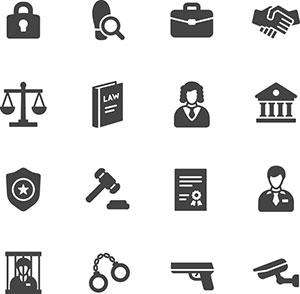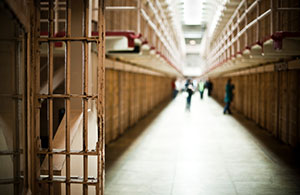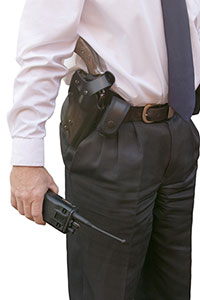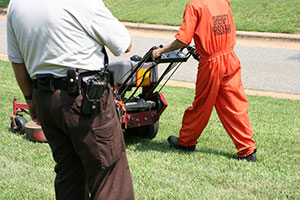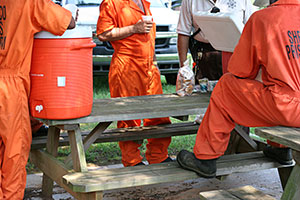What is a Correctional Officer?
Corrections officers have multidimensional roles in facility operations. Regardless of their assignment, be it to oversee general population inmates or to supervise inmates on death row, a correctional officer is required to perform tasks that simultaneously ensure peace and order in the facility, and provide dignified and safe living conditions.
Inmate Intake, Supervision and Release
Some of the basic duties of corrections officers concern the documentation of inmates, from the day they are escorted to the facility until the day of release or transfer to another court-mandated institution.
Inmate Intake- The booking of inmates begins with admission and reception procedures, which include checking personal records and creating a file that documents each inmate's stay in the facility. Admission and reception involves checking inmates' state of health, documenting and appropriately storing personal belongings, and classifying inmates according to their security risk.
Inmate Supervision- First among the many activities that fall under the category of supervision is conducting inmate counts, which occurs several times a day to ensure that all inmates are accounted for. It also involves monitoring activity within and outside of the cells, and disciplining inmates for violations of rules and regulations.
Supervision also involves checking whether or not inmates are performing their mandated tasks, such as kitchen and laundry duties, and alerting members of the correctional healthcare team if an inmate is in need of medical attention. Submitting incident reports, and filing periodic reports that will be used to evaluate inmate progress is also a primary component of a correctional officers supervisory role. Other responsibilities include: providing inmates impartial and sound advice on corrections procedures, reinforcing positive outcomes of good behavior and guiding inmates on proper conduct during drills and simulations pertaining to emergency situations.
Inmate Release- When inmates have served their sentence, or if they are ordered by the courts to leave the facility permanently, corrections officers assigned to them are expected to review files, prepare release paperwork, and file necessary reports.
During the process of release, the departing inmate's behavior and health conditions are documented, and all stored personal belongings are returned. The documentation of this process accompanies the inmate's permanent correctional records, and the final evaluation may be included in the release orders.
Patrols, Inspections and Searches of the Person
Corrections officers observe a set of protocols and routinely perform tasks toward the maintenance of peace and order within the facility. Failure to do so could result in irreversible consequences that impact an entire community, and endanger innocent lives.
Patrols- The aim of patrols is to detect suspicious activity within the premises and in its immediate surroundings. The frequency of patrols are not disclosed to inmates, to prevent these from designing plans to escape or engage in violence. Minimum-security or low-risk facilities do not require corrections officers on patrol to be armed.
Inspections- The aim of inspections is to keep facility conditions secure, safe, peaceful, healthy, and orderly. In order to achieve this, corrections officers conduct routine checks on the inmates' living quarter and activity areas, structures and equipment, visitor belongings and personal effects, and inbound and outbound deliveries.
Being typically designated to housing units, corrections officers are responsible for, among others, checking the facilities for broken locks and light bulbs, corroded bars and fixtures, unserviceable equipment and other facility installations. The scope of their responsibilities extend to inspecting mail matter, which could be a vehicle for illegal substances and dangerous material.
Searches of the Person- As with inspections, the aim of searches of person is to maintain secure and safe facility conditions. This is by conducting legally permissible checks, to see whether or not subject individuals are carrying items that may be detrimental to the security and safety of facility personnel, inmates, and other people. There are four types of searches of the person:
- Pat-Down Search
- Cloathed-Body Search
- Strip Search
- Body-Cavity Search
Especially in strip searches and body-cavity searches, the presence of multiple corrections officers and/or higher-authority endorsements is required. This is to ensure that the corrections officers do not abuse their authority, and that they are not liable for any offense that may be lodged against them.
REMEMBER- Searches of the person not only apply to inmates, but to personnel and visitors as well. The applicability is guaranteed under the Fourth Amendment, but the procedures need to be within the prescribed guidelines. Seizing contraband articles and hazardous material, and submitting individuals involved to legal procedures, may be necessary, although this has to be done within the prescribed guidelines as well.
Emergency Preparedness, Response and Management
Although it is not required by law, a comprehensive emergency plan must be regarded as an important, indispensable component of facility policy. This blueprint goes beyond the common drills-and-simulations program, and must outline the roles and response levels of corrections personnel and their charges in times of emergency (natural calamities and man-made disasters).
The goal is to be well-coordinated in the response and management of critical incidents, and thus save lives and property, prevent the spread of threat, and preserve the integrity of the institution.
Some emergencies that corrections officers should have the capability to respond to are:
- Fire, earthquake, flooding.
- Life threatening medical situations.
- Entry of hazardous materials (HZMAT).
- Outbreak of transmittable disease.
- Outbreak of violence.
- Bomb threat.
- Taking of hostages.
- Inmate escape.
- Food strike.
The moment they detect the occurrence of any critical incident, corrections officers must act quickly and efficiently. Among their initial responses is to respond in their own capacity (if, for example, it is a medical situation that requires the swift and timely administration of first aid); to report the incident to the concerned authorities, with urgency; to contain the threat, and prevent it from spreading; and/or to evacuate endangered persons as necessary.
Corrections officers are not necessarily armed to the hilt, and may not be able to address the situation with efficacy. In these instances, they should follow the emergency plan that requires them to call properly trained and adequately equipped teams as soon as possible.
CERTs (Correctional Emergency Response Teams)- Most facilities, especially the high-risk ones, activate and maintain special operations groups called the correctional emergency response teams (CERTs). These CERTs are corrections officers who compose the facilities' human defenses against breaches of the peace and security. They are trained and equipped to withstand extreme physical challenges, usually posed by errant inmates. Commonly, they are summoned for cell extractions, which involve inmates who do not want to submit to rules and regulations, or inmates who threaten the safety of others.
First Aid- Corrections officers are trained in first aid, including the administration of cardiopulmonary resuscitation (or CPR) and the application of the automated external defibrillator (or AED) that can immediately normalize an individual suffering from cardiac arrest.
Administrative Duties
More than the operational functions, the corrections profession performs administrative duties. It also extends to counseling and mentoring of charges insofar as complete reform and rehabilitation is concerned.
Report Writing
Logging incidents and evaluating inmates form part of the documentation process that is required by law, and which is used as a tool in improving the corrections system.
To be effective, corrections officers must follow directions in writing reports, and they must be conscious performing correct mathematical operations and language. Above all, they must be able to enter details (time, date, place, among others) with accuracy and truthfulness. That they are going to sign these reports means that corrections officers are held responsible for any information and explanation entered therein.
Inmate Counseling
Corrections officers are trained to identify basic factors that can influence criminal behavior, and must use knowledge and common sense to manage the suspicious or unseemly conduct of their charges.
Although they are not psychologists or behavioral therapists, corrections officers are usually regarded by their charges as person to trust. Under these circumstances, particularly when charges confide in them, corrections officers must exercise sound judgment and provide immediate, impartial counsel.
For example, an inmate manifests suicidal tendencies and suddenly tells a corrections officer that he plans to kill himself. The corrections officer must do what a friend does, which is to listen to the inmate and give advice, then report the matter to superiors in order to spare the life of the troubled inmate. The situation should be handled accordingly, based on facility policy.
Stress Management
The corrections profession can prove to be demanding and wearisome: physically, mentally, and emotionally. It is only proper for corrections officers to manage their stress, and thus enable themselves to function well within an intense environment.
Facilities often have programs that address stress, and it is highly recommended that corrections officers participate in these. The activities can include relaxation and meditation, which are also beneficial in improving situational-reasoning and problem-solving skills in extreme conditions.




